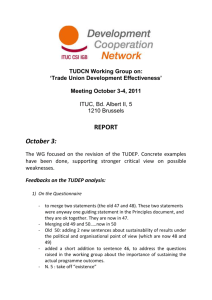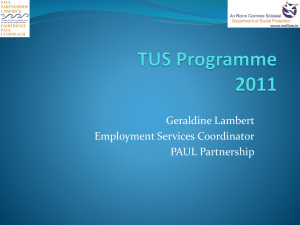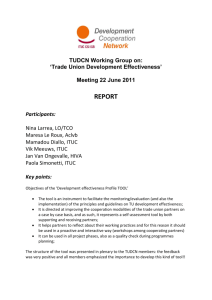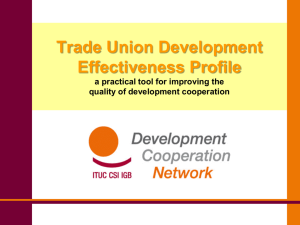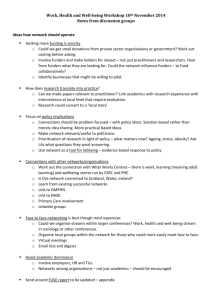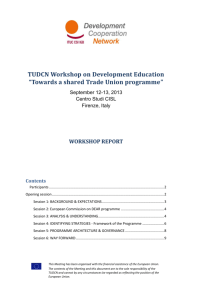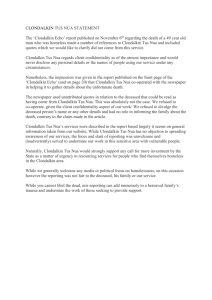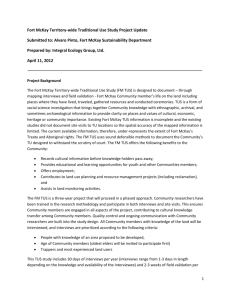- International Trade Union Confederation
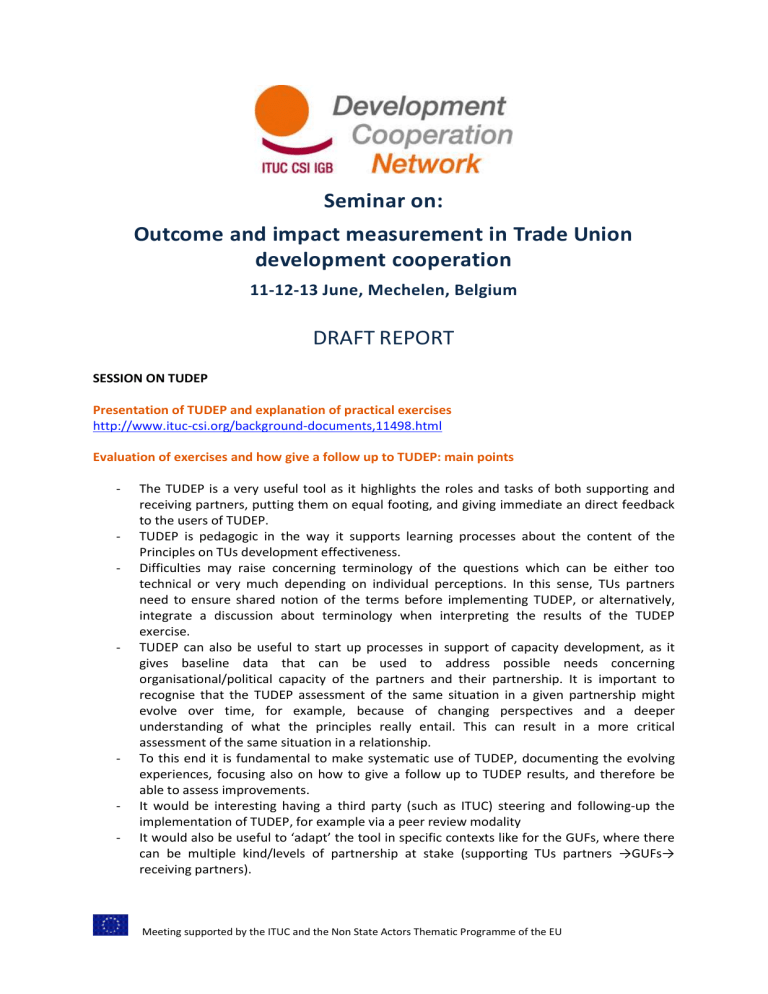
Seminar on:
Outcome and impact measurement in Trade Union development cooperation
11-12-13 June, Mechelen, Belgium
DRAFT REPORT
SESSION ON TUDEP
Presentation of TUDEP and explanation of practical exercises http://www.ituc-csi.org/background-documents,11498.html
Evaluation of exercises and how give a follow up to TUDEP: main points
The TUDEP is a very useful tool as it highlights the roles and tasks of both supporting and receiving partners, putting them on equal footing, and giving immediate an direct feedback to the users of TUDEP.
TUDEP is pedagogic in the way it supports learning processes about the content of the
Principles on TUs development effectiveness.
Difficulties may raise concerning terminology of the questions which can be either too technical or very much depending on individual perceptions. In this sense, TUs partners need to ensure shared notion of the terms before implementing TUDEP, or alternatively, integrate a discussion about terminology when interpreting the results of the TUDEP exercise.
TUDEP can also be useful to start up processes in support of capacity development, as it gives baseline data that can be used to address possible needs concerning organisational/political capacity of the partners and their partnership. It is important to recognise that the TUDEP assessment of the same situation in a given partnership might evolve over time, for example, because of changing perspectives and a deeper understanding of what the principles really entail. This can result in a more critical assessment of the same situation in a relationship.
To this end it is fundamental to make systematic use of TUDEP, documenting the evolving experiences, focusing also on how to give a follow up to TUDEP results, and therefore be able to assess improvements.
It would be interesting having a third party (such as ITUC) steering and following-up the implementation of TUDEP, for example via a peer review modality
It would also be useful to ‘adapt’ the tool in specific contexts like for the GUFs, where there can be multiple kind/levels of partnership at stake (supporting TUs partners →GUFs→ receiving partners).
Meeting supported by the ITUC and the Non State Actors Thematic Programme of the EU
Conclusions/Recommendations
In case of difficulties in understanding the meaning of the questions in the TUDEP, it is strongly recommended to go back to the Principles & Guidelines text, as TUDEP is based on this. TUDEP is by nature intrinsically linked to the Principles and its utilisation cannot be seen detached from them. On this basis, it is recommended to make an overall introduction on the main contents and objectives of the Principles. To get more tips on implementation: http://www.ituc-csi.org/IMG/pdf/tudep_manual_en-3.pdf
.
It is also recommended to put the TUDEP implementation in a ‘dynamic process’ context, focusing also on how to give a follow up to TUDEP results. To get more tips on how to frame the follow up: http://www.ituc-csi.org/IMG/pdf/guidance_notehow_to_make_sense_of_tudep_results_2012.pdf
.
The secretariat will finally reflect on possible solutions to allow more flexibility and adaptation of the TUDEP structure to multiple levels partnerships.
Next steps
TUDEP has been widely disseminated and presented to almost all supporting TUs organisations through various events: TUDCN general meetings, bilateral meetings, EU structured dialogue, Nordic
–Dutch/GUFs meeting, and finally the current seminar.
The next challenge is indeed promoting TUDEP towards the partner organisations in the South, so that they can have the same knowledge and familiarity with the utilisation of the instrument.
Therefore, the TUDCN secretariat will organise specific training sessions at regional level, involving regional organisations and national centres. Supporting partners will be also welcome to take part.
TUDEP training at regional level will be implemented in 2013.
SESSION ON OUTCOME AND IMPACT MEASUREMENT FOR TU S
Why Tacking M&E strategies?
The TUDEP itself refers specifically to elements of M&E, i.e.: Accountability….Q 26. Both partners develop/use common and shared M&E tools that serve both accountability and learning purposes.
Coherence….Q 35. The partners measure the progress towards the achievement of the Decent Work
Agenda and organisational strengthening.
The challenges for TUs to undertake assessment exercises in their development work are considerable linked to the very complex nature of TUs work in development: i.e. interaction with different players, unpredictable political and power dynamics; and the fact that the benefits are often beyond the direct target groups.
The seminar served as a start for a reflection on how TUs can strengthen their M&E methodologies and approaches at the outcome and impact level so that they can be more adaptable to TUs specificities.
This will imply the gradual development and formulation of shared components of the M&E framework as to:
Meeting supported by the ITUC and the Non State Actors Thematic Programme of the EU
Assess progress in achieving results at various levels, and use these insights for learning and improving the programmes;
Set a common and shared approach on how to measure at these levels.
Measurement of progress can be done at various levels: project level, national and global level
(outputs/outcome/impact), and in various ways (based on a different agenda and a different set of principles & values, tools, etc.). These issues were systematically addressed in the seminar.
However, the seminar started by taking stock of on-going initiatives by other institutional actors (ILO
& OECD-Development Centre), especially looking at how they are assessing progress towards development goals such as the Decent Work Agenda and other international frameworks . Two examples of organisations pursuing these objectives: see ppt presentations of OECD Development
Centre and ILO: http://www.ituc-csi.org/background-documents,11498.html
After these presentations, the seminar took the specific perspective of trade unions as a starting point to present and exchange on the components of a shared M&E practice.
TU outcome and impact measurement: making the bridge with ILO DW indicators http://www.ituc-csi.org/background-documents,11498.html
The main aim of this working session was focused on the role of the Decent Work Agenda in the
M&E activities of TUs. The session highlighted the challenges in defining casual linkages between outcome and impact level, and the difficulty of re-constructing causal chains with indicators for each level. ILO DWA pillars were taken as starting point/framework for analysis, being the main point of reference for TUs. In the ‘guidance note’ document, a first draft of a set of indicators is presented at output, outcome, and impact level for each component of the DW agenda. During the presentation, the various methodological challenges with constructing such a table were highlighted. Over time, once the table is reviewed and refined it can be used as a support reference tool to track progress/achievements against the DWI.
The groups were asked to provide FEEDBACK ON THE TABLE WITH THE DECENT WORK INDICATORS
(see p.17 ‘guidance note’ document): what is missing?
Group I (rights at work)
• Translation into French not clear- it needs to be revised
• Horizontal logic was not always clear, eg. Child labour
• Gender theme: some phases were missing, too big jump
• Levels are not always well positioned: impact indicator is actually outcome indicator …
• Gender: ‘knowledge’ is not the right indicator at that level
• The first column requires a title
• If we focus too much on these specific indicators we might actually lose out of sight other issues
• Methodology: clearer instructions would have helped to get more focus
Group II (employment)
• Some indicators are not positioned at the right level
Meeting supported by the ITUC and the Non State Actors Thematic Programme of the EU
• Some examples are not relevant for a TU context: micro-credit or micro-entrepreneurship, increasing production
• Capacity of southern TUs should be more weighted
Group III (social protection)
• Clarity of the indicators to be reviewed
• Many examples are referring to ‘outcomes’ and not to ‘impact’
• Do we want generic indicators? Are they best examples?
• Can we actually measure causal relationships between all these indicators at different levels? Should we be more realistic and focus on outcomes where organisational capacity is prioritized?
• Importance of capacity development ~ outcome level: should it be a separate category or further integrated?
Group IV (social dialogue)
Output level
Social dialogue: limited nr of examples (eg. Research..depends on the national context)
Also illiteracy should be taken into account
Outcome level:
Employers are missing
Legislation is missing, including ILO
Cross-cutting issues missing: gender..
Also national, international, regional, sectoral, levels: missing
Some are not formulated as indicators
Indicators for 3 levels: OD, ID,..
Impact:
ILO indicators phrased in negative way: better more positively (increase in conflict resolution…)
Usefulness of the table with the DWIs at different levels:
What could be useful for us -> towards back donors (bridging donors expectations with our needs): donors assume that we can easily jump from the outcome level to the impact level: we need to educate our back donors about this
We need to be realistic that the table will not be representing the whole reality (can we come-up with a more complexity-oriented approach/visualisation: cyclical instead of linear?)
Should we come up with lists of indicators? Positioning of indicators can depend on the programme and on the type of actor you’re looking at
We should be clear about who is talking or whom we are talking to: is the 4 th column relevant for our partners?
Is ‘impact-indicator’ a useful concept in our context? Should we rather talk about ‘vision’, eg in the context of informal sector work.
From which perspective the data is collected is important: ITUC can play an important role at impact level mapping the contributions of individual organisations
Meeting supported by the ITUC and the Non State Actors Thematic Programme of the EU
Preliminary conclusions
On the basis of the discussion, it seems clear that the actual purpose of the table is questioned: whether it should serve more to TUs internal needs or to meet donors’ expectations.
Maybe the two options are not necessarily mutually excluding. The table has to be completed adding the important capacity development component in TU work, referring to the support to organisational and political development of partner organisations in the south, which should be our primary concern. Consequently, more emphasis will be given to the outcome level (indicators).
The secretariat will review the table on the basis of these approaches, and will circulate again to participants the new version.
Agenda and Principles for a shared Monitoring &Evaluation approach
The idea of this session was to brainstorm on the pillars of M&E, analysing what should be the aim of doing M&E, and what should be the underlying principles (see ‘guidance document’ p. 5)
Agenda: Key ideas
• How can we reconcile learning oriented M&E with the fast speed of change on the one hand and the obligations for detailed long-term planning towards donors on the other hand?
• Is there a trade-off between learning and accountability? Can we strike a balance? Can you
‘learn’ while being also accountable?
• Two logics of accountability & learning: one towards the donor and one towards the receiving partners-> should we base our approach more on how the receiving partners organise M&E and develop themselves?
• Supporting organisations should not impose their reality/needs when it comes to the what and how of monitoring and evaluation
• Hierarchy in learning needs: receiving partners/supporting partners/donors
• Hierarchy in accountability needs: workers/receiving partners/supporting partners/donors
• Evaluation is an important process to learn about progress, and adjust the planning accordingly
• Aid is dwarfing against other financial flows: we need to take this reality into account, and evolve with our logics according to this.
• Additional aims to do M&E: keeping people motivated in their own work
Principles: what is missing?
Group I
1: Ok with principle 1, but last sentence should be split, and not put against each other
2: ok
3: formulate in positive sense: ‘prioritizing analysis and decision making at local level. Biological metaphor is too difficult jargon
4: ‘taking into account’ is not a useful expression, rather ‘guarantee’
5: is ‘measuring’ not too strong….? Not sure. Rather ‘validating or underwriting’.
6: Focusing and information sharing (not only feedback) for mutual learning
7: ok
8: Harmonising the M&E principles as an additional principles
Group II
Meeting supported by the ITUC and the Non State Actors Thematic Programme of the EU
1: local processes important, but putting more focus on ‘harmonisation’ (between donors, and between supporting and receiving partners)
2: ok
3: replace ‘local and horizontal sense-making’ with ‘joint local….’
4: (a) in respect of internal decision making processes in TUs, (b) involvement of beneficiaries in
M&E is not always realistic in TU work
5: is it a principle? It is more about ‘what’ than ‘how’. Is ‘measuring’ needed in this principle?
6 & 7: ok, but clarifying what it means ‘equal access to knowledge’. Being partners does not mean that you can ask everything about your partners (including financial information on internal issues)
Group III
Broader discussion about M&E:
TUs cannot / should not become ‘project-based organisations’, and can therefore
-
also not be M&E specialists as NGOs
Explain more clearly what is ‘output-outcome-..’ in a TU context
Importance of capacity of TUs: the focus should be on indicators at outcome level,
-
-
-
-
maybe more than on DW
Principles are quite generic, not specifically for TUs
Problem of involving ultimate beneficiaries in PM&E biological metaphor is not linked with TU reality measuring DW as principle is prescriptive, and still object for discussion
‘Measuring CD’ as an important principle. Should it be integrated further in principle
5?
Additional Principles
• M&E in a TU context should have a permanent character and should be institutionalised
• M&E should be based on the TUs specificities, for example, decision making processes are very different from NGOs, as TUs are member based organisations: agenda-setting follows representative structures, implementation must be more participatory:
– we should respect existing decision-making structures in a given context (Busan parallel with ‘use of country-systems’ discussion)
– M&E should reflect the nature of the relationship between the TU structures
• Harmonisation would be excellent although not easy (see the Dutch-Nordic),
– Importance of having receiving orgs call for harmonisation
– ITUC could facilitate harmonisation
• Sharing baseline information between supporting partners needs to be improved (tried out in Burma, Philippines, China...)
• ITUC did a survey on donor support for TU development work (18 countries): we need to slowly push back (see next meeting in Paris in October)
• TUDEP: is a specific element of TU work and it should be more prominent in the Principles
Preliminary conclusions
The debate has raised interesting views on the very objective of M&E reflecting possible dichotomy between the learning logic on one hand and accountability needs on the other. Going back again to the TUs Principles, they outline clear streams of accountability, putting in the first place workers, and that the members ‘trade union partners are responsible to their members for giving account of the actions they have taken. They should be involved and aware of the contribution of cooperation initiatives in the enhancement of their living and working conditions in general and the
Meeting supported by the ITUC and the Non State Actors Thematic Programme of the EU
improvement in the quality of their trade union work in particular’. On this basis, it seems crucial to highlight more the differences between NGOs and TUs which are based on representative structures and therefore also M&E methodologies should be backed by a strong participatory approach using
‘organisational systems’ in place at country level.
Furthermore, since TUs are not ‘project-based organisations’, more emphasis should be put on capacity development of TUs partner organisations. Therefore, the focus should be on indicators at outcome level, more than on DW impact level.
Finally, the document is very good in the first part, when addressing specific challenges of TUs in monitoring progress, but then a number of participants find that it falls again in the NGO approach in the second part when tackling M&E principles and tools. The TUs approach on M&E should be better described. The secretariat will review the principles on the basis of the observations received, and will circulate again to participants the new version.
Logic of change in M&E: Basic concepts
We cannot talk about ‘project’ but rather of ‘TU partners’ work plan’
Why do we need to aggregate information?
– Compare between projects
– Getting a picture of the overall situation and communicating about this
– Demands of the back-donor: management overviews
– Motivating to map progress at a larger scale
What kind of information can be aggregated?
– Mapping successful examples
– Differences of context can make aggregation useless
– Need to contextualise information which is aggregated
Appropriate Monitoring &Evaluation tools and methods for TU development work
The flow chart needs to be further explained, maybe adding links to specific methodologies as not everyone is acquainted with them.
Preliminary conclusions
ITUC/TUDCN could play a useful role in facilitating information sharing and mapping successful examples and in supporting shared evaluation processes in pilot countries
Conclusions and Way forward
Specific points on the guidance document
The draft guidance document has been positively received by participants concerning both structure and overall contents;
However, we need to work further on the draft guidance document, adding more specificity and peculiarity of TUs for a shared approach on M&E;
Meeting supported by the ITUC and the Non State Actors Thematic Programme of the EU
Also the link to the Principles and to the TUDEP should be much more highlighted in the guidance document.
Future perspectives- long term
The guidance document (and this work in general on M&E) can be used in a two pronged strategy: 1) internal level: improving capacity and coordination on TUs M&E approaches; 2) external level: using the document as a political tool to show to our back donors the specificity of TUs in development cooperation and its assessment;
However, before approaching donors, we need to work more on the internal process in the first place, involving consultations of regional organisations and national TUs centres in the
South;
This has to be seen as a learning oriented process aimed at sharing common understanding on M&E and prioritizing southern partners priorities (priorities of the partner organisations v. project objectives)
This is why TUs own approaches to M&E should prioritize accountability to strategic priorities of the target organisations, fostering their organisational capacity development
(building on local capacities) and political capacity in recording/presenting achievements
(bottom-up processes)
There is still a lot of ‘ignorance’ among us, and we need to learn more on what methodologies we use and what results we achieve. A web information sharing platform would be very useful
In this sense TUDCN can play a key role in strengthening coordination among TUs partners when it comes to M&E methodologies, as well as, it can help aggregation of results for impact assessment
‘Joint country impact studies’ (in selected pilot countries) could be one example to implement principles and instruments of M&E (based on the guidance document). To this end we will need to outline common Terms of References
Next Steps – short term
New version of the document will be circulated by the end of August
Comments and Feedbacks during the month of September
Further revision of the document: October
…..November: WG on TUs Development Effectiveness meeting. Outcomes expected: finalisation of the draft document and conception of a specific strategy to start the consultation at regional level in 2013
Overall process
2012 2013
Meeting supported by the ITUC and the Non State Actors Thematic Programme of the EU
M&E
Finalisation of the ‘guidance’ document on TUs Regional consultations: Africa, Asia, Latin
America
Meeting supported by the ITUC and the Non State Actors Thematic Programme of the EU
